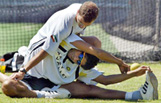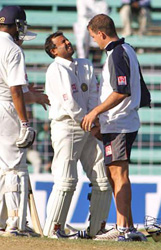COACHING
Cricket and physical fitness
A player should be physically fit to last the strain of a match of a longer duration. To achieve this, he will have to do exercises every day for about 30 minutes viz; running round the cricket field, skipping, free arm and bending exercises. It is also advisable to do some exercise before the start of the game so as to tune up your muscles.Many players suffer from cramps during a match. This is mainly due to loss of salt through perspiration. One should therefore drink water (avoid ice-cold water) with little salt put in it, to compensate for the loss. As far as possible, avoid late nights, drinking and smoking, especially when you are undergoing training or when a match is in progress.
Every sportsman should attempt to achieve a level of fitness specific to the demands of his sport. For this, a proper training programme should be planned. The exercises performed by the player should be general as well as specific to the sport.
The year can be divided into three periods that are suitable for training;
A. Preparatory month:
Specific exercises that will enhance a player's performance should be done during this period. Training will improve his strength, speed, agility, mobility, endurance, coordination and balance, his cardio-vascular and respiratory systems. A training programme should consist of strengthening exercises, lifting lightweights, stretching of all muscles, jogging and long-distance running. This is the period in which the player, be he a bowler or a batsman, should develop his technique to help him achieve the optimum level of performance.
B. Competitive months:
With the training done and techniques developed in previous months, the player will be ready to put in his best efforts.
C. Transition months (Off-season):
In this period, the amount of training should be reduced and over-stress avoided. Other 'relaxation sports' could be taken up. Injuries of any kind are best treated during this period with adequate amounts of rest and light exercises so that 'de-conditioning' does not occur.

Ganguly and Tendulkar warm up
A basic workout consists of warming up, stretching,
strengthening and cooling down.
A warm-up is essential before any match. It helps the body to gradually adapt to the change in its physical state i.e. from resting state to exercising. As a result, the player also gets mentally geared up for the competition. An adequate warm-up minimizes the risk of injury to muscles, tendons, ligaments and other connective tissues. On match days, the warm-up could be done for 20 minutes and on other days for 45 minutes. It usually begins 30-40 minutes before a game and is reduced 10-15 minutes before the match and ends five minutes before the match. This tapering period and rest allows recovery from any fatigue without any loss of the effect of the warm-up. The warm-up should not be too intense as it can deteriorate a player's performance due to fatigue and tiredness.
A warm-up is essential before any match. It helps the body to gradually adapt to the change in its physical state i.e. from resting state to exercising. As a result, the player also gets mentally geared up for the competition. An adequate warm-up minimizes the risk of injury to muscles, tendons, ligaments and other connective tissues. On match days, the warm-up could be done for 20 minutes and on other days for 45 minutes. It usually begins 30-40 minutes before a game and is reduced 10-15 minutes before the match and ends five minutes before the match. This tapering period and rest allows recovery from any fatigue without any loss of the effect of the warm-up. The warm-up should not be too intense as it can deteriorate a player's performance due to fatigue and tiredness.
A warm-up includes jogging and stretching - specific exercises that are necessary for the sport in question. Warm-up exercises comprise neck, shoulder and arm exercises, and stretching exercises for the back and legs. The leg muscles that should be stretched are the hamstrings, quadriceps, groin muscles and calf muscles.
STRETCHING
Stretching is an integral part of the warm-up routine but it does not in itself constitute a complete warm-up. It involves holding oneself comfortably in a stretched position for various lengths of time. There should be no bouncing, no bobbing up or down or other movements. When stretching correctly, one should try to be as still as a statue. Only a mild tension should be felt in the muscle that is being stretched. If there is pain during stretching, it implies that the muscle is being overstretched. Overstretching is useless and will only cause an injury or tear of the muscle. For an easy stretch, the stretched position should be held for 10-30 seconds without the player feeling any discomfort. This is important because it reduces muscle tension, maintains flexibility and reduces or prevents soreness and is thus helpful in preventing muscular injuries such as pulls and tears.

Ashish Nehra 'stretches' himself with the help of Indian team physio Andrew Leipus
Mobility exercises are also an important part of
the training regime. The individual should develop
the capacity to perform joint actions through a
wide range of motion. Every player must maintain a
general level of mobility in order to avoid
injuries, meet the demands of his technique and
improve his performance e.g. A bowler should have
good shoulder mobility. Mobility exercises should
be done regularly and sets of exercises should
comprise 10-15 repetitions, as only after several
repetitions is there any visible increase in the
range of movement. The end position of the stretch
should be maintained for 6-10 seconds in each
repetition.
Besides mobility, strengthening of the muscles is important to ensure that along with the demands of mobility, the demands of stability are also met. Strength is a person's ability to do work against a load or resistance. It is a basic physical characteristic that determines performance efficiency in a sport. The player can develop or acquire strength through working encounters. As the strength increases, the load should be progressively increased. Along with general exercises for body strengthening, specific groups of muscles should also be strengthened, depending upon the particular action they perform e.g. A fast bowler will have to strengthen his legs muscles as well as shoulder and arm muscles to enable him to meet the demands of his bowling. Endurance can be increased by performing 'lower resistance' exercises, but with a higher number of repetitions.

On-field first-aid - Leipus tends to Nayan Mongia's injured thumb
COOLING DOWN
At the end of the workout or match, cooling down is important. This reduces muscle soreness, relaxes the player, breaks down muscle spasm and removes waste products from the muscle collected during the exercises. The player relaxes and feels comfortable.
DIET
A proper, balanced diet is essential for any player. The player should have his meals atleast two hours before the start of a training schedule or the match itself. A light meal is preferable as it is easily digestible. Plenty of fluids should be consumed to replenish the body fluids lost due to excessive perspiration. Boiled foods should be preferred to oily, fried food.
INJURY AND TREATMENT
Injuries are common in each and every sport. The immediate treatment or First-aid that can be given when there is pain, swelling and tenderness together with pain on movement or when load is applied is as follows:
At the end of the workout or match, cooling down is important. This reduces muscle soreness, relaxes the player, breaks down muscle spasm and removes waste products from the muscle collected during the exercises. The player relaxes and feels comfortable.
DIET
A proper, balanced diet is essential for any player. The player should have his meals atleast two hours before the start of a training schedule or the match itself. A light meal is preferable as it is easily digestible. Plenty of fluids should be consumed to replenish the body fluids lost due to excessive perspiration. Boiled foods should be preferred to oily, fried food.
INJURY AND TREATMENT
Injuries are common in each and every sport. The immediate treatment or First-aid that can be given when there is pain, swelling and tenderness together with pain on movement or when load is applied is as follows:
Rest to the injured part to avoid further damage. Application of ice will help to reduce the pain and swelling. Ice-packs, ice-cubes in a plastic bag or napkin may be applied over the injured area.
Following this, a compression bandage that comprises an elastic bandage should be tied around the injured area with some amount of pressure to check the swelling. Elevation of the injured limb reduces the swelling.
This treatment can be carried out for a period of 24-48 hours in cases of soft tissue injuries. Any form of heat treatment should be avoided in the acute stage as this may result in increased swelling and pain. Later, a physiotherapist or sports medicine specialist should be consulted.
For injuries like fractures, dislocations and severe soft tissue injuries, medical help should be considered immediately. The injured part should be well supported to prevent further damage.
Rehabilitation and training after injuries require special knowledge on the part of the injured player and the coach. The exercise programme after the injury should begin carefully with a gradual increase of load to pain threshold.
A proper warm-up is essential. Initially, isometric exercises are advised without load. The load may be increased gradually as healing permits, and dynamic exercises started. But the pain threshold should not be exceeded.